Progress on In Situ and Operando X-ray Imaging of Solidification Processes
Abstract
1. Introduction
2. A Brief Review of Techniques
2.1. An Overview of X-ray Imaging Techniques for Metals Processing
2.2. Overview of In Situ and Operando (ISO) Environmental Cell Techniques
3. X-ray Imaging of Solidification Processes
3.1. X-ray Imaging of Solidification Microstructures
3.1.1. Imaging Using Laboratory X-ray Sources
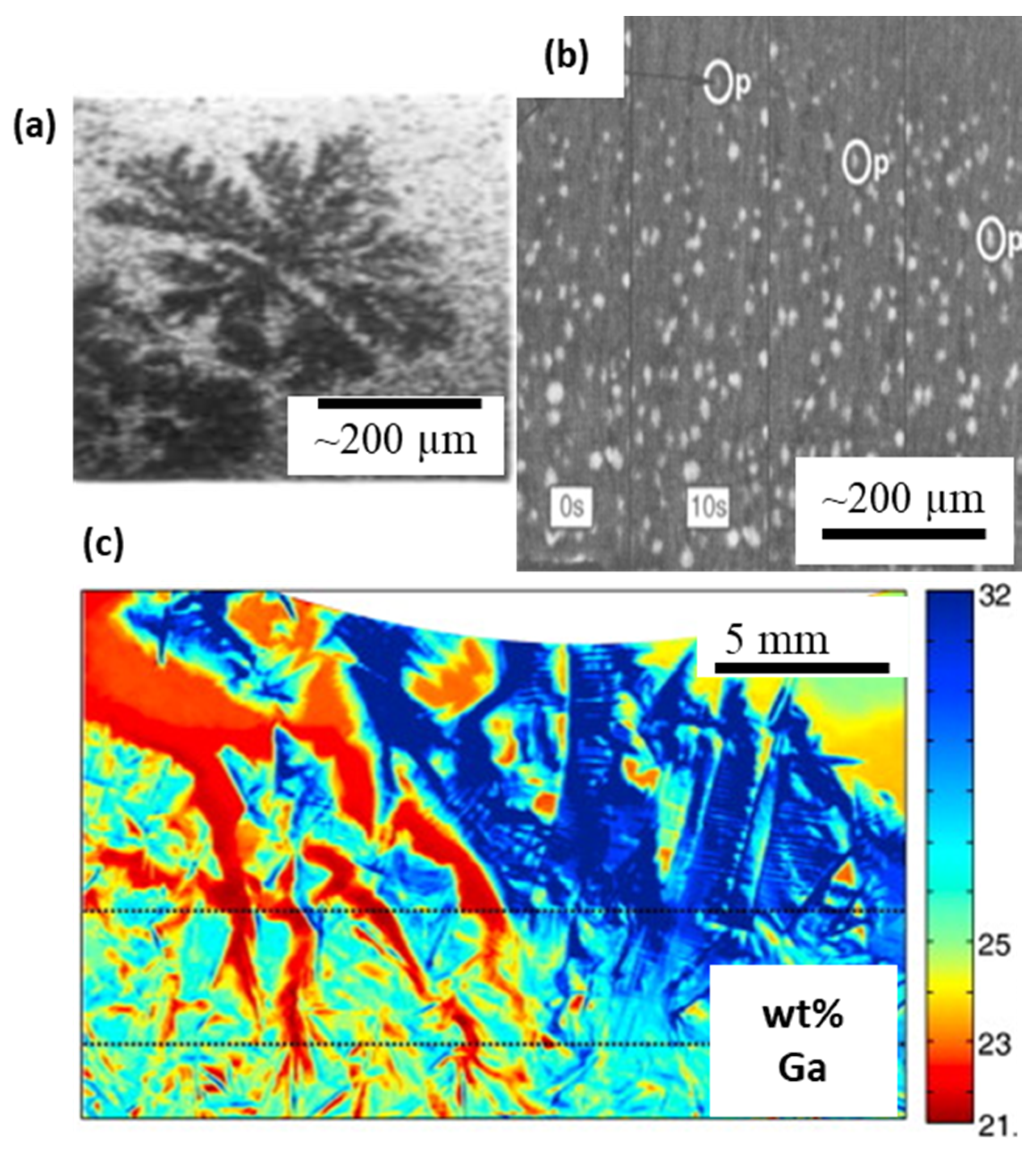
3.1.2. Synchrotron X-ray Investigations of Solidification
3.2. X-ray Imaging of Semi-Solid Deformation
4. The Future? In Situ Imaging for Ultra-Fast Solidification Processing, Additive Manufacturing
4.1. In Situ and Operando X-ray Imaging of LPBF
4.2. In Situ and Operando X-ray Diffraction of LPBF
5. The Outlook of In Situ and Operando X-ray Imaging
6. Concluding Remarks
Funding
Acknowledgments
Conflicts of Interest
References
- Dantzig, J.A.; Rappaz, M. Solidification, 2nd ed.; Engineering Sciences; EFPL Press: Lausanne, Switzerland, 2016; ISBN 9780849382383. [Google Scholar]
- Boettinger, W.J.; Coriell, S.R.; Greer, A.L.; Karma, A.; Kurz, W.; Rappaz, M.; Trivedi, R. Solidification microstructures: Recent developments, future directions. Acta Mater. 2000, 48, 43–70. [Google Scholar] [CrossRef]
- Beckermann, C. Modelling of macrosegregation: Applications and future needs. Int. Mater. Rev. 2002, 47, 243–262. [Google Scholar] [CrossRef]
- Baruchel, J.; Buffiere, J.Y.; Maire, E. X-ray Tomography in Material Science; Hermes Science Publications: Paris, France, 2000. [Google Scholar]
- Gong, X.; Anderson, T.; Chou, K. Review on powder-based electron beam additive manufacturing technology. Manuf. Rev. 2014, 1, 2. [Google Scholar] [CrossRef]
- Herzog, D.; Seyda, V.; Wycisk, E.; Emmelmann, C. Additive manufacturing of metals. Acta Mater. 2016, 117, 371–392. [Google Scholar] [CrossRef]
- Rau, C.; Weitkamp, T.; Snigirev, A.A.; Schroer, C.G.; Benner, B.; Tuemmler, J.; Guenzler, T.F.; Kuhlmann, M.; Lengeler, B.; Krill, C.E., III; et al. Tomography with high resolution. In Proceedings of the International Symposium on Optical Science and Technology; Bonse, U., Ed.; SPIE: San Diego, CA, USA; Volume 4503, p. 14.
- Cunningham, R.; Zhao, C.; Parab, N.; Kantzos, C.; Pauza, J.; Fezzaa, K.; Sun, T.; Rollett, A.D. Keyhole threshold and morphology in laser melting revealed by ultrahigh-speed x-ray imaging. Science 2019, 363, 849–852. [Google Scholar] [CrossRef] [PubMed]
- Bak, S.-M.; Shadike, Z.; Lin, R.; Yu, X.; Yang, X.-Q. In situ/operando synchrotron-based X-ray techniques for lithium-ion battery research. NPG Asia Mater. 2018, 10, 563–580. [Google Scholar] [CrossRef]
- Nguyen-Thi, H.; Salvo, L.; Mathiesen, R.H.; Arnberg, L.; Billia, B.; Suery, M.; Reinhart, G. On the interest of synchrotron X-ray imaging for the study of solidification in metallic alloys. Comptes Rendus Phys. 2012, 13, 237–245. [Google Scholar] [CrossRef]
- Stampanoni, M.; Groso, A.; Isenegger, A.; Mikuljan, G.; Chen, Q.; Bertrand, A.; Henein, S.; Betemps, R.; Frommherz, U.; Böhler, P.; et al. Trends in synchrotron-based tomographic imaging: The SLS experience. In Proceedings of the SPIE OPTICS + PHOTONICS, San Diego, CA, USA, 13–17 August 2006; Volume 6318, p. 63180M. [Google Scholar]
- Chahine, G.A.; Blanc, N.; Arnaud, S.; De Geuser, F.; Guinebretière, R.; Boudet, N. Advanced Non-Destructive in Situ Characterization of Metals with the French Collaborating Research Group D2AM/BM02 Beamline at the European Synchrotron Radiation Facility. Metals 2019, 9, 352. [Google Scholar] [CrossRef]
- Calta, N.P.; Wang, J.; Kiss, A.M.; Martin, A.A.; Depond, P.J.; Guss, G.M.; Thampy, V.; Fong, A.Y.; Weker, J.N.; Stone, K.H.; et al. An instrument for in situ time-resolved X-ray imaging and diffraction of laser powder bed fusion additive manufacturing processes. Rev. Sci. Instrum. 2018, 89, 055101. [Google Scholar] [CrossRef] [PubMed]
- Maire, E.; Withers, P.J. Quantitative X-ray tomography. Int. Mater. Rev. 2014, 59, 1–43. [Google Scholar] [CrossRef]
- Dario, A.; Sicim, H.O.; Balikci, E. A comparative study on the growth of germanium–silicon single crystals grown by the vertical Bridgman and axial heat processing techniques. J. Cryst. Growth 2012, 351, 1–8. [Google Scholar] [CrossRef]
- Miller, E.W.J.; Beech, J. In-situ radiographic observations of alloy solidification. Metallography 1972, 5, 298–300. [Google Scholar] [CrossRef]
- Karagadde, S.; Yuan, L.; Shevchenko, N.; Eckert, S.; Lee, P.D. 3-D microstructural model of freckle formation validated using in situ experiments. Acta Mater. 2014, 79, 168–180. [Google Scholar] [CrossRef]
- Karagadde, S.; Sundarraj, S.; Dutta, P. A model for growth and engulfment of gas microporosity during aluminum alloy solidification process. Comput. Mater. Sci. 2012, 65, 383–394. [Google Scholar] [CrossRef]
- Yang, B.; Wang, Z. Image-based modelling for fluid flow and permeability prediction within continuously-evolving mushy zone during melting and solidification. Int. J. Heat Mass Transf. 2020, 147, 119000. [Google Scholar] [CrossRef]
- Fuloria, D.; Lee, P.D. An X-ray microtomographic and finite element modeling approach for the prediction of semi-solid deformation behaviour in Al – Cu alloys. Acta Mater. 2009, 57, 5554–5562. [Google Scholar] [CrossRef]
- Fife, J.L.; Rappaz, M.; Pistone, M.; Celcer, T.; Mikuljan, G.; Stampanoni, M. Development of a laser-based heating system for {\it in~situ} synchrotron-based X-ray tomographic microscopy. J. Synchrotron Radiat. 2012, 19, 352–358. [Google Scholar] [CrossRef]
- Karagadde, S.; Lee, P.D.; Cai, B.; Fife, J.L.; Azeem, M.A.; Kareh, K.M.; Puncreobutr, C.; Tsivoulas, D.; Connolley, T.; Atwood, R.C. Transgranular liquation cracking of grains in the semi-solid state. Nat. Commun. 2015, 6, 8300. [Google Scholar] [CrossRef]
- Azeem, M.A.; Lee, P.D.; Phillion, A.B.; Karagadde, S.; Rockett, P.; Atwood, R.C.; Courtois, L.; Rahman, K.M.; Dye, D. Revealing dendritic pattern formation in Ni, Fe and Co alloys using synchrotron tomography. Acta Mater. 2017, 128, 241–248. [Google Scholar] [CrossRef]
- Schenk, T.; Nguyen Thi, H.; Gastaldi, J.; Reinhart, G.; Cristiglio, V.; Mangelinck-Noël, N.; Klein, H.; Härtwig, J.; Grushko, B.; Billia, B.; et al. Application of synchrotron X-ray imaging to the study of directional solidification of aluminium-based alloys. J. Cryst. Growth 2005, 275, 201–208. [Google Scholar] [CrossRef]
- Hojjatzadeh, S.M.H.; Parab, N.D.; Guo, Q.; Qu, M.; Xiong, L.; Zhao, C.; Escano, L.I.; Fezzaa, K.; Everhart, W.; Sun, T.; et al. Direct observation of pore formation mechanisms during LPBF additive manufacturing process and high energy density laser welding. Int. J. Mach. Tools Manuf. 2020, 153, 103555. [Google Scholar] [CrossRef]
- Leung, C.L.A.; Marussi, S.; Towrie, M.; del Val Garcia, J.; Atwood, R.C.; Bodey, A.J.; Jones, J.R.; Withers, P.J.; Lee, P.D. Laser-matter interactions in additive manufacturing of stainless steel SS316L and 13-93 bioactive glass revealed by in situ X-ray imaging. Addit. Manuf. 2018, 24, 647–657. [Google Scholar] [CrossRef]
- Guo, Q.; Zhao, C.; Qu, M.; Xiong, L.; Escano, L.I.; Hojjatzadeh, S.M.H.; Parab, N.D.; Fezzaa, K.; Everhart, W.; Sun, T.; et al. In-situ characterization and quantification of melt pool variation under constant input energy density in laser powder bed fusion additive manufacturing process. Addit. Manuf. 2019, 28, 600–609. [Google Scholar] [CrossRef]
- Lee, S.G.; Gokhale, A.M. Formation of gas induced shrinkage porosity in Mg-alloy high-pressure die-castings. Scr. Mater. 2006, 55, 387–390. [Google Scholar] [CrossRef]
- Bhagavath, S.; Cai, B.; Atwood, R.; Li, M.; Ghaffari, B.; Lee, P.D.; Karagadde, S. Combined Deformation and Solidification-Driven Porosity Formation in Aluminum Alloys. Metall. Mater. Trans. A 2019, 50, 4891–4899. [Google Scholar] [CrossRef]
- Li, W.; Vairis, A.; Preuss, M.; Ma, T. Linear and rotary friction welding review. Int. Mater. Rev. 2016, 61, 71–100. [Google Scholar] [CrossRef]
- Mathiesen, R.H.; Arnberg, L.; Li, Y.; Meier, V.; Schaffer, P.L.; Snigireva, I.; Snigirev, A.; Dahle, A.K. X-ray Videomicroscopy Studies of Eutectic Al-Si Solidification in Al-Si-Cu. Metall. Mater. Trans. A 2011, 42, 170–180. [Google Scholar] [CrossRef]
- Puncreobutr, C.; Lee, P.D.; Hamilton, R.W.; Cai, B.; Connolley, T. Synchrotron Tomographic Characterization of Damage Evolution During Aluminum Alloy Solidification. Metall. Mater. Trans. A 2012, 44, 5389–5395. [Google Scholar] [CrossRef]
- Puncreobutr, C.; Lee, P.D.; Kareh, K.M.; Connolley, T.; Fife, J.L.; Phillion, A.B. Influence of Fe-rich intermetallics on solidification defects in Al-Si-Cu alloys. Acta Mater. 2014, 68, 42–51. [Google Scholar] [CrossRef]
- Gourlay, C.M.; Dahle, A.K. Dilatant shear bands in solidifying metals. Nature 2007, 445, 70–73. [Google Scholar] [CrossRef]
- Nagira, T.; Gourlay, C.M.; Sugiyama, A.; Uesugi, M.; Kanzawa, Y.; Yoshiya, M.; Uesugi, K.; Umetani, K.; Yasuda, H. Direct observation of deformation in semi-solid carbon steel. Scr. Mater. 2011, 64, 1129–1132. [Google Scholar] [CrossRef]
- Kou, S. A criterion for cracking during solidification. Acta Mater. 2015, 88, 366–374. [Google Scholar] [CrossRef]
- Bale, H.A.; Haboub, A.; MacDowell, A.A.; Nasiatka, J.R.; Parkinson, D.Y.; Cox, B.N.; Marshall, D.B.; Ritchie, R.O. Real-time quantitative imaging of failure events in materials under load at temperatures above 1600 °C. Nat. Mater. 2013, 12, 40–46. [Google Scholar] [CrossRef] [PubMed]
- Clarke, A.J.; Tourret, D.; Imhoff, S.D.; Gibbs, P.J.; Fezzaa, K.; Cooley, J.C.; Lee, W.-K.; Deriy, A.; Patterson, B.M.; Papin, P.A.; et al. X-ray Imaging and Controlled Solidification of Al-Cu Alloys Toward Microstructures by Design. Adv. Eng. Mater. 2015, 17, 454–459. [Google Scholar] [CrossRef]
- Mi, J.; Tan, D.; Lee, T.L. In Situ Synchrotron X-ray Study of Ultrasound Cavitation and Its Effect on Solidification Microstructures. Metall. Mater. Trans. B 2015, 46, 1615–1619. [Google Scholar] [CrossRef]
- Maire, E.; Buffière, J.Y.; Salvo, L.; Blandin, J.J.; Ludwig, W.; Létang, J.M. On the Application of X-ray Microtomography in the Field of Materials Science. Adv. Eng. Mater. 2001, 3, 539–546. [Google Scholar] [CrossRef]
- Tourret, D.; Mertens, J.C.E.; Lieberman, E.; Imhoff, S.D.; Gibbs, J.W.; Henderson, K.; Fezzaa, K.; Deriy, A.L.; Sun, T.; Lebensohn, R.A.; et al. From Solidification Processing to Microstructure to Mechanical Properties: A Multi-scale X-ray Study of an Al-Cu Alloy Sample. Metall. Mater. Trans. A 2017, 48, 5529–5546. [Google Scholar] [CrossRef]
- Hocine, S.; Van Swygenhoven, H.; Van Petegem, S.; Chang, C.S.T.; Maimaitiyili, T.; Tinti, G.; Ferreira Sanchez, D.; Grolimund, D.; Casati, N. Operando X-ray diffraction during laser 3D printing. Mater. Today 2020, 34, 30–40. [Google Scholar] [CrossRef]
- Wang, H.; Atwood, R.C.; Pankhurst, M.J.; Kashyap, Y.; Cai, B.; Zhou, T.; Lee, P.D.; Drakopoulos, M.; Sawhney, K. High-energy, high-resolution, fly-scan X-ray phase tomography. Sci. Rep. 2019, 9, 8913. [Google Scholar] [CrossRef]
- Atwood, R.C.; Bodey, A.J.; Price, S.W.T.; Basham, M.; Drakopoulos, M. A high-throughput system for high-quality tomographic reconstruction of large datasets at Diamond Light Source. Philos. Trans. R. Soc. A Math. Phys. Eng. Sci. 2015, 373, 20140398. [Google Scholar] [CrossRef]
- Vo, N.T.; Atwood, R.C.; Moser, H.O.; Lee, P.D.; Breese, M.B.H.; Drakopoulos, M. A fast-converging iterative method for X-ray in-line phase contrast tomography. Appl. Phys. Lett. 2012, 101, 224108. [Google Scholar] [CrossRef]
- Kazantsev, D.; Van Eyndhoven, G.; Lionheart, W.R.B.; Withers, P.J.; Dobson, K.J.; McDonald, S.A.; Atwood, R.; Lee, P.D. Employing temporal self-similarity across the entire time domain in computed tomography reconstruction. Philos. Trans. R. Soc. A Math. Phys. Eng. Sci. 2015, 373, 20140389. [Google Scholar] [CrossRef] [PubMed]
- Cloetens, P.; Barrett, R.; Baruchel, J.; Guigay, J.-P.; Schlenker, M. Phase objects in synchrotron radiation hard x-ray imaging. J. Phys. D. Appl. Phys. 1996, 29, 133–146. [Google Scholar] [CrossRef]
- Basham, M.; Filik, J.; Wharmby, M.T.; Chang, P.C.Y.; El Kassaby, B.; Gerring, M.; Aishima, J.; Levik, K.; Pulford, B.C.A.; Sikharulidze, I.; et al. Data Analysis WorkbeNch (DAWN). J. Synchrotron Radiat. 2015, 22, 853–858. [Google Scholar] [CrossRef] [PubMed]
- Wadeson, N.; Basham, M. Savu: A Python-based, MPI Framework for Simultaneous Processing of Multiple, N-dimensional, Large Tomography Datasets. arXiv 2016, arXiv:1610.08015. [Google Scholar]
- Mirone, A.; Brun, E.; Gouillart, E.; Tafforeau, P.; Kieffer, J. The PyHST2 hybrid distributed code for high speed tomographic reconstruction with iterative reconstruction and a priori knowledge capabilities. Nucl. Instrum. Methods Phys. Res. Sect. B Beam Interact. Mater. Atoms 2014, 324, 41–48. [Google Scholar] [CrossRef]
- Gürsoy, D.; De Carlo, F.; Xiao, X.; Jacobsen, C. TomoPy: A framework for the analysis of synchrotron tomographic data. J. Synchrotron Radiat. 2014, 21, 1188–1193. [Google Scholar] [CrossRef]
- Phillion, A.B.; Cockcroft, S.L.; Lee, P.D. X-ray micro-tomographic observations of hot tear damage in an Al–Mg commercial alloy. Scr. Mater. 2006, 55, 489–492. [Google Scholar] [CrossRef][Green Version]
- Arnberg, L.; Mathiesen, R.H. The real-time, high-resolution X-ray video microscopy of solidification in aluminum alloys. JOM 2007, 59, 20–26. [Google Scholar] [CrossRef]
- Ramirez, A.; Chen, L.; Bergeon, N.; Billia, B.; Gu, J.; Trivedi, R. In situ and real time characterization of interface microstructure in 3D alloy solidification: Benchmark microgravity experiments in the DECLIC-Directional Solidification Insert on ISS. IOP Conf. Ser. Mater. Sci. Eng. 2012, 27, 012087. [Google Scholar] [CrossRef]
- Suéry, M.; Terzi, S.; Mireux, B.; Salvo, L.; Adrien, J.; Maire, E. Fast In Situ X-ray Microtomography Observations of Solidification and Semisolid Deformation of Al-Cu Alloys. Jom 2012, 64, 83–88. [Google Scholar] [CrossRef]
- Gibbs, P.J.; Imhoff, S.D.; Morris, C.L.; Merrill, F.E.; Wilde, C.H.; Nedrow, P.; Mariam, F.G.; Fezzaa, K.; Lee, W.-K.; Clarke, A.J. Multiscale X-ray and Proton Imaging of Bismuth-Tin Solidification. JOM 2014, 66, 1485–1492. [Google Scholar] [CrossRef]
- Landron, C.; Maire, E.; Adrien, J.; Bouaziz, O.; Di Michiel, M.; Cloetens, P.; Suhonen, H. Resolution effect on the study of ductile damage using synchrotron X-ray tomography. Nucl. Instruments Methods Phys. Res. Sect. B Beam Interact. Mater. Atoms 2012, 284, 15–18. [Google Scholar] [CrossRef]
- Leung, C.L.A.; Marussi, S.; Atwood, R.C.; Towrie, M.; Withers, P.J.; Lee, P.D. In situ X-ray imaging of defect and molten pool dynamics in laser additive manufacturing. Nat. Commun. 2018, 9, 1355. [Google Scholar] [CrossRef]
- Reinhart, G.; Grange, D.; Abou-Khalil, L.; Mangelinck-Noël, N.; Niane, N.T.; Maguin, V.; Guillemot, G.; Gandin, C.-A.; Nguyen-Thi, H. Impact of solute flow during directional solidification of a Ni-based alloy: In-situ and real-time X-radiography. Acta Mater. 2020, 194, 68–79. [Google Scholar] [CrossRef]
- Bhreasail, Á.N.; Lee, P.D.; O’Sullivan, C.; Fenton, C.H.; Hamilton, R.; Rockett, P.; Connolley, T. In-Situ Observation of Cracks in Frozen Soil using Synchrotron Tomography. Permafr. Periglac. Process. 2012, 23, 170–176. [Google Scholar] [CrossRef]
- Cai, B.; Karagadde, S.; Yuan, L.; Marrow, T.J.; Connolley, T.; Lee, P.D. In situ synchrotron tomographic quantification of granular and intragranular deformation during semi-solid compression of an equiaxed dendritic Al–Cu alloy. Acta Mater. 2014, 76, 371–380. [Google Scholar] [CrossRef]
- Yasuda, H.; Nagira, T.; Yoshiya, M.; Nakatsuka, N.; Sugiyama, A. Development of X-ray Imaging for Observing Solidification of Carbon Stels. ISIJ Int. 2011, 51, 402–408. [Google Scholar] [CrossRef]
- Liotti, E.; Lui, A.; Vincent, R.; Kumar, S.; Guo, Z.; Connolley, T.; Dolbnya, I.P.; Hart, M.; Arnberg, L.; Mathiesen, R.H.; et al. A synchrotron X-ray radiography study of dendrite fragmentation induced by a pulsed electromagnetic field in an Al–15Cu alloy. Acta Mater. 2014, 70, 228–239. [Google Scholar] [CrossRef]
- Bhagavath, S.; Cai, B.; Atwood, R.; Lee, P.D.; Karagadde, S. Effects of strain rate on hot tear formation in Al-Si-Cu alloys. IOP Conf. Ser. Mater. Sci. Eng. 2019, 529, 012053. [Google Scholar] [CrossRef]
- Arzilli, F.; La Spina, G.; Burton, M.R.; Polacci, M.; Le Gall, N.; Hartley, M.E.; Di Genova, D.; Cai, B.; Vo, N.T.; Bamber, E.C.; et al. Magma fragmentation in highly explosive basaltic eruptions induced by rapid crystallization. Nat. Geosci. 2019, 12, 1023–1028. [Google Scholar] [CrossRef]
- Titarenko, S.; Titarenko, V.; Kyrieleis, A.; Withers, P.J. A ring artifact suppression algorithm based on a priori information. Appl. Phys. Lett. 2009, 95, 071113. [Google Scholar] [CrossRef]
- Limodin, N.; Salvo, L.; Suéry, M.; DiMichiel, M. In situ investigation by X-ray tomography of the overall and local microstructural changes occurring during partial remelting of an Al–15.8 wt.% Cu alloy. Acta Mater. 2007, 55, 3177–3191. [Google Scholar] [CrossRef]
- Shevchenko, N.; Boden, S.; Gerbeth, G.; Eckert, S. Chimney Formation in Solidifying Ga-25wt pct In Alloys Under the Influence of Thermosolutal Melt Convection. Metall. Mater. Trans. A 2013, 44, 3797–3808. [Google Scholar] [CrossRef]
- Arganda-Carreras, I.; Kaynig, V.; Rueden, C.; Eliceiri, K.W.; Schindelin, J.; Cardona, A.; Seung, H.S. Trainable Weka Segmentation: A machine learning tool for microscopy pixel classification. Bioinformatics 2017, 33, 2424–2426. [Google Scholar] [CrossRef]
- Seo, H.; Badiei Khuzani, M.; Vasudevan, V.; Huang, C.; Ren, H.; Xiao, R.; Jia, X.; Xing, L. Machine learning techniques for biomedical image segmentation: An overview of technical aspects and introduction to state-of-art applications. Med. Phys. 2020, 47, e148–e167. [Google Scholar] [CrossRef]
- Schindelin, J.; Arganda-Carreras, I.; Frise, E.; Kaynig, V.; Longair, M.; Pietzsch, T.; Preibisch, S.; Rueden, C.; Saalfeld, S.; Schmid, B. Fiji: An open-source platform for biological-image analysis. Nat. Methods 2012, 9, 676–682. [Google Scholar] [CrossRef]
- Jackson, K.A.; Hunt, J.D. Transparent compounds that freeze like metals. Acta Metall. 1965, 13, 1212–1215. [Google Scholar] [CrossRef]
- Forsten, J.; Meikk-Oja, H.M. Radiographic Observations of the Solidification of Metals. J. Inst. Met. 1965, 95, 143–145. [Google Scholar]
- Glicksman, M.E.; Vold, C.L. Observation of solidification and melting phenomena in metals using the electron microscope. Acta Metall. 1967, 15, 1409–1412. [Google Scholar] [CrossRef]
- Kaukler, W.F.; Rosenberger, F. X-ray microscopic observations of metal solidification dynamics. Metall. Mater. Trans. A 1994, 25, 1775–1777. [Google Scholar] [CrossRef]
- Miller, E.W.J.; Stephenson, M.P.; Beech, J. A technique for the direct observation of alloy solidification. J. Phys. E. 1975, 8, 33–37. [Google Scholar] [CrossRef]
- Lee, P.D.; Hunt, J.D. Hydrogen porosity in directional solidified aluminium-copper alloys: In situ observation. Acta Mater. 1997, 45, 4155–4169. [Google Scholar] [CrossRef]
- Curreri, P.; Kaukler, W. Real-Time X-ray transmission microscopy of solidifying Al-In Alloys. Metall. Mater. Trans. A 1996, 27, 801–808. [Google Scholar] [CrossRef]
- Chalmers, B. Principles of Solidification; Springer: Boston, MA, USA, 1977. [Google Scholar]
- Tiwari, S.N.; Beech, J. Origin of gas bubbles in aluminium. Met. Sci. 1978, 12, 356–362. [Google Scholar] [CrossRef]
- Giamei, A.F.; Kear, B.H. On the nature of freckles in nickel base superalloys. Metall. Trans. 1970, 1, 2185–2192. [Google Scholar] [CrossRef]
- Lee, P.D.; Hunt, J.D. Hydrogen porosity in directionally solidified aluminium-copper alloys: A mathematical model. Acta Mater. 2001, 49, 1383–1398. [Google Scholar] [CrossRef]
- Atwood, R.C.; Sridhar, S.; Zhang, W.; Lee, P.D. Diffusion-controlled growth of hydrogen pores in aluminium-silicon castings: In situ observation and modelling. Acta Mater. 2000, 48, 405–417. [Google Scholar] [CrossRef]
- Atwood, R.C.; Lee, P.D. Simulation of the three-dimensional morphology of solidification porosity in an aluminium-silicon alloy. Acta Mater. 2003, 51, 5447–5466. [Google Scholar] [CrossRef]
- Lee, P.D.; Chirazi, A.; Atwood, R.C.; Wang, W. Multiscale modelling of solidification microstructures, including microsegregation and microporosity, in an Al-Si-Cu alloy. Mater. Sci. Eng. A 2004, 365, 57–65. [Google Scholar] [CrossRef]
- Wang, W.; Lee, P.D.; McLean, M. A model of solidification microstructures in nickel-based superalloys: Predicting primary dendrite spacing selection. Acta Mater. 2003, 51, 2971–2987. [Google Scholar] [CrossRef]
- Boden, S.; Eckert, S.; Gerbeth, G. Visualization of freckle formation induced by forced melt convection in solidifying GaIn alloys. Mater. Lett. 2010, 64, 1340–1343. [Google Scholar] [CrossRef]
- Shevchenko, N.; Boden, S.; Eckert, S.; Borin, D.; Heinze, M.; Odenbach, S. Application of X-ray radioscopic methods for characterization of two-phase phenomena and solidification processes in metallic melts. Eur. Phys. J. Spec. Top. 2013, 220, 63–77. [Google Scholar] [CrossRef]
- Kumar, V.; Srivastava, A.; Karagadde, S. Compositional dependency of double-diffusive layers during binary alloy solidification: Full-field measurements and quantification. Phys. Fluids 2018, 30, 113603. [Google Scholar] [CrossRef]
- Yuan, L.; Lee, P.D. A new mechanism for freckle initiation based on microstructural level simulation. Acta Mater. 2012, 60, 4917–4926. [Google Scholar] [CrossRef]
- Saad, A.; Gandin, C.A.; Bellet, M.; Shevchenko, N.; Eckert, S. Simulation of Channel Segregation During Directional Solidification of In—75 wt pct Ga. Qualitative Comparison with In Situ Observations. Metall. Mater. Trans. A Phys. Metall. Mater. Sci. 2015, 46, 4886–4897. [Google Scholar] [CrossRef]
- Matsumiya, T.; Yamada, W.; Ohashi, T.; Nittono, O. In situ observation of solidification of silicon steel by synchrotron radiation X-ray topography. Metall. Mater. Trans. A 1987, 18, 723–727. [Google Scholar] [CrossRef]
- Grange, G.; Gastaldi, J.; Jourdon, C.; Billia, B. Real-time topography of microstructures in a binary alloy. Synchrotron Radiat. News 1994, 7, 12–15. [Google Scholar] [CrossRef]
- Mathiesen, R.H.; Arnberg, L.; Mo, F.; Weitkamp, T.; Snigirev, A. Time Resolved X-ray Imaging of Dendritic Growth in Binary Alloys. Phys. Rev. Lett. 1999, 83, 5062–5065. [Google Scholar] [CrossRef]
- Wang, J.; Lee, P.D.; Hamilton, R.W.; Li, M.; Allison, J. The kinetics of Fe-rich intermetallic formation in aluminium alloys: In situ observation. Scr. Mater. 2009, 60, 516–519. [Google Scholar] [CrossRef]
- Mathiesen, R.H.; Arnberg, L. X-ray radiography observations of columnar dendritic growth and constitutional undercooling in an Al–30wt%Cu alloy. Acta Mater. 2005, 53, 947–956. [Google Scholar] [CrossRef]
- Parab, N.D.; Fezzaa, K.; Rollett, A.D.; Escano, L.I.; Everhart, W.; Cunningham, R.; Chen, L.; Sun, T.; Zhao, C. Ultrafast X-ray imaging of laser–metal additive manufacturing processes. J. Synchrotron Radiat. 2018, 25, 1467–1477. [Google Scholar] [CrossRef] [PubMed]
- Mathiesen, R.H.; Arnberg, L.; Li, Y.; Dahle, A.K. In-situ X-ray video microscopy studies of Al-Si eutectic solidification. In Proceedings of the 12th International Conference on Aluminium Alloys, Yokohama, Japan, 5–9 September 2010; pp. 1267–1272. [Google Scholar]
- Yasuda, H.; Ohnaka, I.; Kawasaki, K.; Sugiyama, A.; Ohmichi, T.; Iwane, J.; Umetani, K. Direct observation of stray crystal formation in unidirectional solidification of Sn–Bi alloy by X-ray imaging. J. Cryst. Growth 2004, 262, 645–652. [Google Scholar] [CrossRef]
- Yasuda, H.; Yamamoto, Y.; Nakatsuka, N.; Nagira, T.; Yoshiya, M.; Sugiyama, A.; Ohnaka, I.; Umetani, K.; Uesugi, K. In situ observation of nucleation, fragmentation and microstructure evolution in Sn-Bi and Al-Cu alloys. Int. J. Cast Met. Res. 2008, 21, 125–128. [Google Scholar] [CrossRef]
- Salvo, L.; Suéry, M.; Marmottant, A.; Limodin, N.; Bernard, D. 3D imaging in material science: Application of X-ray tomography. Comptes Rendus Phys. 2010, 11, 641–649. [Google Scholar] [CrossRef]
- Park, C.-L.; Voorhees, P.W.; Thornton, K. Application of the level-set method to the analysis of an evolving microstructure. Comput. Mater. Sci. 2014, 85, 46–58. [Google Scholar] [CrossRef]
- Losert, W.; Shi, B.Q.; Cummins, H.Z. Evolution of dendritic patterns during alloy solidification: Onset of the initial instability. Proc. Natl. Acad. Sci. USA 1998, 95, 431–438. [Google Scholar] [CrossRef]
- Shankar, S.; Riddle, Y.W.; Makhlouf, M.M. Eutectic solidification of aluminum-silicon alloys. Metall. Mater. Trans. A 2004, 35, 3038–3043. [Google Scholar] [CrossRef]
- Yasuda, H.; Morishita, K.; Nakatsuka, N.; Nishimura, T.; Yoshiya, M.; Sugiyama, A.; Uesugi, K.; Takeuchi, A. Dendrite fragmentation induced by massive-like δ–γ transformation in Fe–C alloys. Nat. Commun. 2019, 10, 3183. [Google Scholar] [CrossRef]
- Kareh, K.M.; O’Sullivan, C.; Nagira, T.; Yasuda, H.; Gourlay, C.M. Dilatancy in semi-solid steels at high solid fraction. Acta Mater. 2017, 125, 187–195. [Google Scholar] [CrossRef]
- Azeem, M.A.; Bjerre, M.K.; Atwood, R.C.; Tiedje, N.; Lee, P.D. Synchrotron quantification of graphite nodule evolution during the solidification of cast iron. Acta Mater. 2018, 155, 393–401. [Google Scholar] [CrossRef]
- Cai, B.; Wang, J.; Kao, A.; Pericleous, K.; Phillion, A.B.; Atwood, R.C.; Lee, P.D. 4D synchrotron X-ray tomographic quantification of the transition from cellular to dendrite growth during directional solidification. Acta Mater. 2016, 117, 160–169. [Google Scholar] [CrossRef]
- Eskin, D.G.; Suyitno; Katgerman, L. Mechanical properties in the semi-solid state and hot tearing of aluminium alloys. Prog. Mater. Sci. 2004, 49, 629–711. [Google Scholar] [CrossRef]
- Rappaz, M. Modeling and characterization of grain structures and defects in solidification. Curr. Opin. Solid State Mater. Sci. 2016, 20, 37–45. [Google Scholar] [CrossRef]
- Cai, B.; Karagadde, S.; Rowley, D.; Marrow, T.J.; Connolley, T.; Lee, P.D. Time-resolved synchrotron tomographic quantification of deformation-induced flow in a semi-solid equiaxed dendritic Al–Cu alloy. Scr. Mater. 2015, 103, 69–72. [Google Scholar] [CrossRef]
- Shen, H.F.; Beckermann, C. An experimental study of deformation of a columnar dendritic mushy zone using a transparent succinonitrile-acetone alloy. Metall. Mater. Trans. B 2002, 33, 69–78. [Google Scholar] [CrossRef]
- Kareh, K.M.; Lee, P.D.; Atwood, R.C.; Connolley, T.; Gourlay, C.M. Revealing the micromechanisms behind semi-solid metal deformation with time-resolved X-ray tomography. Nat Commun 2014, 5, 4464. [Google Scholar] [CrossRef]
- Pekguleryuz, M.O.; Li, X.; Aliravci, C.A. In-Situ Investigation of Hot Tearing in Aluminum Alloy AA1050 via Acoustic Emission and Cooling Curve Analysis. Metall. Mater. Trans. A 2009, 40, 1436–1456. [Google Scholar] [CrossRef]
- Luo, Y.; Wu, S.C.; Hu, Y.N.; Fu, Y.N. Cracking evolution behaviors of lightweight materials based on in situ synchrotron X-ray tomography: A review. Front. Mech. Eng. 2018, 13, 461–481. [Google Scholar] [CrossRef]
- Phillion, A.B.; Hamilton, R.W.; Fuloria, D.; Leung, A.C.L.; Rockett, P.; Connolley, T.; Lee, P.D. In situ X-ray observation of semi-solid deformation and failure in Al–Cu alloys. Acta Mater. 2011, 59, 1436–1444. [Google Scholar] [CrossRef]
- Terzi, S.; Salvo, L.; Suéry, M.; Limodin, N.; Adrien, J.; Maire, E.; Pannier, Y.; Bornert, M.; Bernard, D.; Felberbaum, M.; et al. In situ X-ray tomography observation of inhomogeneous deformation in semi-solid aluminium alloys. Scr. Mater. 2009, 61, 449–452. [Google Scholar] [CrossRef]
- Phillion, A.B.; Lee, P.D.; Maire, E.; Cockcroft, S.L. Quantitative Assessment of Deformation-Induced Damage in a Semisolid Aluminum Alloy via X-ray Microtomography. Metall. Mater. Trans. A 2008, 39, 2459–2469. [Google Scholar] [CrossRef]
- Gourlay, C.M.; Dahle, A.K.; Nagira, T.; Nakatsuka, N.; Nogita, K.; Uesugi, K.; Yasuda, H. Granular deformation mechanisms in semi-solid alloys. Acta Mater. 2011, 59, 4933–4943. [Google Scholar] [CrossRef]
- Puncreobutr, C.; Lee, P.D.; Hamilton, R.W.; Phillion, A.B. Quantitative 3D Characterization of Solidification Structure and Defect Evolution in Al Alloys. JOM 2012, 64, 89–95. [Google Scholar] [CrossRef]
- Puncreobutr, C.; Phillion, A.B.; Fife, J.L.; Lee, P.D. Coupling in situ synchrotron X-ray tomographic microscopy and numerical simulation to quantify the influence of intermetallic formation on permeability in aluminium—silicon—copper alloys. Acta Mater. 2014, 64, 316–325. [Google Scholar] [CrossRef]
- Yuan, L.; O’Sullivan, C.; Gourlay, C.M. Exploring dendrite coherency with the discrete element method. Acta Mater. 2012, 60, 1334–1345. [Google Scholar] [CrossRef]
- Katz, R.F.; Spiegelman, M.; Holtzman, B. The dynamics of melt and shear localization in partially molten aggregates. Nature 2006, 442, 676–679. [Google Scholar] [CrossRef]
- Meylan, B.; Terzi, S.; Gourlay, C.M.; Dahle, A.K. Dilatancy and rheology at 0–60% solid during equiaxed solidification. Acta Mater. 2011, 59, 3091–3101. [Google Scholar] [CrossRef]
- Fonseca, J.; O’Sullivan, C.; Nagira, T.; Yasuda, H.; Gourlay, C.M. In situ study of granular micromechanics in semi-solid carbon steels. Acta Mater. 2013, 61, 4169–4179. [Google Scholar] [CrossRef]
- Kareh, K.M.; Lee, P.D.; Gourlay, C.M. Globule-globule interactions during deformation in semi-solid Al-Cu using time-resolved X-ray tomography. In Proceedings of the Semi-Solid Processing of Alloys And Composites XII; Moller, H., Govender, G., Eds.; Trans Tech Publications Ltd.: Zurich, Switzerland, 2013; Volume 192–193, pp. 179–184. [Google Scholar]
- Sistaninia, M.; Terzi, S.; Phillion, A.B.; Drezet, J.-M.; Rappaz, M. 3-D granular modeling and in situ X-ray tomographic imaging: A comparative study of hot tearing formation and semi-solid deformation in Al–Cu alloys. Acta Mater. 2013, 61, 3831–3841. [Google Scholar] [CrossRef]
- Clarke, A.; Imhoff, S.; Gibbs, P.; Cooley, J.; Morris, C.; Merrill, F.; Hollander, B.; Mariam, F.; Ott, T.; Barker, M.; et al. Proton Radiography Peers into Metal Solidification. Sci. Rep. 2013, 3, 2020. [Google Scholar] [CrossRef]
- Bigot, R.; Favier, V.; Rouff, C. Characterisation of semi-solid material mechanical behaviour by indentation test. J. Mater. Process. Technol. 2005, 160, 43–53. [Google Scholar] [CrossRef]
- Cai, B.; Lee, P.D.; Karagadde, S.; Marrow, T.J.; Connolley, T. Time-resolved synchrotron tomographic quantification of deformation during indentation of an equiaxed semi-solid granular alloy. Acta Mater. 2016, 105, 338–346. [Google Scholar] [CrossRef]
- McDonald, S.A.; Coban, S.B.; Sottos, N.R.; Withers, P.J. Tracking capsule activation and crack healing in a microcapsule-based self-healing polymer. Sci. Rep. 2019, 9, 17773. [Google Scholar] [CrossRef] [PubMed]
- Willers, B.; Eckert, S.; Nikrityuk, P.A.; Räbiger, D.; Dong, J.; Eckert, K.; Gerbeth, G. Efficient melt stirring using pulse sequences of a rotating magnetic field: Part II. Application to solidification of Al-Si alloys. Metall. Mater. Trans. B Process Metall. Mater. Process. Sci. 2008, 39, 304–316. [Google Scholar] [CrossRef]
- Eckert, S.; Nikrityuk, P.A.; Räbiger, D.; Eckert, K.; Gerbeth, G. Efficient melt stirring using pulse sequences of a rotating magnetic field: Part I. Flow field in a liquid metal column (Metallurgical and Materials Transactions B (2007) 38B:6 DOI: 10.1007/s11663-007-9096-4). Metall. Mater. Trans. B Process Metall. Mater. Process. Sci. 2008, 39, 374–386. [Google Scholar] [CrossRef]
- Kao, A.; Cai, B.; Lee, P.D.; Pericleous, K. The effects of Thermoelectric Magnetohydrodynamics in directional solidification under a transverse magnetic field. J. Cryst. Growth 2017, 457, 270–274. [Google Scholar] [CrossRef]
- Wang, F.; Eskin, D.; Mi, J.; Wang, C.; Koe, B.; King, A.; Reinhard, C.; Connolley, T. A synchrotron X-radiography study of the fragmentation and refinement of primary intermetallic particles in an Al-35Cu alloy induced by ultrasonic melt processing. Acta Mater. 2017, 141, 142–153. [Google Scholar] [CrossRef]
- Mirihanage, W.; Xu, W.; Tamayo-Ariztondo, J.; Eskin, D.; Garcia-Fernandez, M.; Srirangam, P.; Lee, P. Synchrotron radiographic studies of ultrasonic melt processing of metal matrix nano composites. Mater. Lett. 2016, 164, 484–487. [Google Scholar] [CrossRef]
- Chen, Y.; Nguyen-Thi, H.; Li, D.Z.; Bogno, A.-A.; Billia, B.; Xiao, N.M. Influence of natural convection on microstructure evolution during the initial solidification transient: Comparison of phase-field modeling with in situ synchrotron X-ray monitoring data. IOP Conf. Ser. Mater. Sci. Eng. 2012, 33, 012102. [Google Scholar] [CrossRef]
- Mirihanage, W.U.; Di Michiel, M.; Reiten, A.; Arnberg, L.; Dong, H.B.; Mathiesen, R.H. Time-resolved X-ray diffraction studies of solidification microstructure evolution in welding. Acta Mater. 2014, 68, 159–168. [Google Scholar] [CrossRef]
- Wang, B.; Tan, D.; Lee, T.L.; Khong, J.C.; Wang, F.; Eskin, D.; Connolley, T.; Fezzaa, K.; Mi, J. Ultrafast synchrotron X-ray imaging studies of microstructure fragmentation in solidification under ultrasound. Acta Mater. 2018, 144, 505–515. [Google Scholar] [CrossRef]
- Yufit, V.; Tariq, F.; Eastwood, D.S.; Biton, M.; Wu, B.; Lee, P.D.; Brandon, N.P. Operando Visualization and Multi-scale Tomography Studies of Dendrite Formation and Dissolution in Zinc Batteries. Joule 2019, 3, 485–502. [Google Scholar] [CrossRef]
- Love, C.T.; Baturina, O.A.; Swider-Lyons, K.E. Observation of Lithium Dendrites at Ambient Temperature and Below. ECS Electrochem. Lett. 2015, 4, A24–A27. [Google Scholar] [CrossRef]
- Deville, S. Ice-templating, freeze casting: Beyond materials processing. J. Mater. Res. 2013, 28, 2202–2219. [Google Scholar] [CrossRef]
- Liotti, E.; Arteta, C.; Zisserman, A.; Lui, A.; Lempitsky, V.; Grant, P.S. Crystal nucleation in metallic alloys using x-ray radiography and machine learning. Sci. Adv. 2018, 4, eaar4004. [Google Scholar] [CrossRef] [PubMed]
- Tolnai, D.; Mendis, C.L.; Stark, A.; Szakács, G.; Wiese, B.; Kainer, K.U.; Hort, N. In situ synchrotron diffraction of the solidification of Mg4Y3Nd. Mater. Lett. 2013, 102–103, 62–64. [Google Scholar] [CrossRef]
- Narumi, T.; Nakata, T.; Kobayashi, R.; Yasuda, H. Time-resolved and in-situ Observation of Semisolid Deformation in Al–Cu Alloys with Equiaxed and Columnar Grain Structures by Using a Combination Technique of 4D-CT and 3DXRD. ISIJ Int. 2021. [Google Scholar] [CrossRef]
- Iqbal, N.; van Dijk, N.H.; Offerman, S.E.; Moret, M.P.; Katgerman, L.; Kearley, G.J. Real-time observation of grain nucleation and growth during solidification of aluminium alloys. Acta Mater. 2005, 53, 2875–2880. [Google Scholar] [CrossRef]
- Lim, C.W.J.; Le, K.Q.; Lu, Q.; Wong, C.H. An Overview of 3-D Printing in Manufacturing, Aerospace, and Automotive Industries. IEEE Potentials 2016, 35, 18–22. [Google Scholar] [CrossRef]
- Calta, N.P.; Martin, A.A.; Hammons, J.A.; Nielsen, M.H.; Roehling, T.T.; Fezzaa, K.; Matthews, M.J.; Jeffries, J.R.; Willey, T.M.; Lee, J.R.I. Pressure dependence of the laser-metal interaction under laser powder bed fusion conditions probed by in situ X-ray imaging. Addit. Manuf. 2020, 32, 101084. [Google Scholar] [CrossRef]
- Kim, T.B.; Yue, S.; Zhang, Z.; Jones, E.; Jones, J.R.; Lee, P.D. Additive manufactured porous titanium structures: Through-process quantification of pore and strut networks. J. Mater. Process. Technol. 2014, 214, 2706–2715. [Google Scholar] [CrossRef]
- Sames, W.J.; List, F.A.; Pannala, S.; Dehoff, R.R.; Babu, S.S. The metallurgy and processing science of metal additive manufacturing. Int. Mater. Rev. 2016, 61, 315–360. [Google Scholar] [CrossRef]
- Sun, T. Probing Ultrafast Dynamics in Laser Powder Bed Fusion Using High-Speed X-ray Imaging: A Review of Research at the Advanced Photon Source. JOM 2020, 72, 999–1008. [Google Scholar] [CrossRef]
- Leung, C.L.A.; Marussi, S.; Towrie, M.; Atwood, R.C.; Withers, P.J.; Lee, P.D. The effect of powder oxidation on defect formation in laser additive manufacturing. Acta Mater. 2019, 166, 294–305. [Google Scholar] [CrossRef]
- Chen, Y.; Clark, S.J.; Leung, C.L.A.; Sinclair, L.; Marussi, S.; Olbinado, M.P.; Boller, E.; Rack, A.; Todd, I.; Lee, P.D. In-situ Synchrotron imaging of keyhole mode multi-layer laser powder bed fusion additive manufacturing. Appl. Mater. Today 2020, 20, 100650. [Google Scholar] [CrossRef]
- Martin, A.A.; Calta, N.P.; Khairallah, S.A.; Wang, J.; Depond, P.J.; Fong, A.Y.; Thampy, V.; Guss, G.M.; Kiss, A.M.; Stone, K.H.; et al. Dynamics of pore formation during laser powder bed fusion additive manufacturing. Nat. Commun. 2019, 10, 1987. [Google Scholar] [CrossRef] [PubMed]
- Thampy, V.; Fong, A.Y.; Calta, N.P.; Wang, J.; Martin, A.A.; Depond, P.J.; Kiss, A.M.; Guss, G.; Xing, Q.; Ott, R.T.; et al. Subsurface Cooling Rates and Microstructural Response during Laser Based Metal Additive Manufacturing. Sci. Rep. 2020, 10, 1981. [Google Scholar] [CrossRef] [PubMed]
- Zhao, C.; Fezzaa, K.; Cunningham, R.W.; Wen, H.; Carlo, F.; Chen, L.; Rollett, A.D.; Sun, T. Real-time monitoring of laser powder bed fusion process using high-speed X-ray imaging and diffraction. Sci. Rep. 2017, 7, 3602. [Google Scholar] [CrossRef]
- Bobel, A.; Hector, L.G.; Chelladurai, I.; Sachdev, A.K.; Brown, T.; Poling, W.A.; Kubic, R.; Gould, B.; Zhao, C.; Parab, N.; et al. In situ synchrotron X-ray imaging of 4140 steel laser powder bed fusion. Materialia 2019, 6, 100306. [Google Scholar] [CrossRef]
- Khairallah, S.A.; Martin, A.A.; Lee, J.R.I.; Guss, G.; Calta, N.P.; Hammons, J.A.; Nielsen, M.H.; Chaput, K.; Schwalbach, E.; Shah, M.N.; et al. Controlling interdependent meso-nanosecond dynamics and defect generation in metal 3D printing. Science 2020, 368, 660–665. [Google Scholar] [CrossRef] [PubMed]
- Zhao, C.; Parab, N.D.; Li, X.; Fezzaa, K.; Tan, W.; Rollett, A.D.; Sun, T. Critical instability at moving keyhole tip generates porosity in laser melting. Science 2020, 370, 1080–1086. [Google Scholar] [CrossRef]
- Sinclair, L.; Leung, C.L.A.; Marussi, S.; Clark, S.J.; Chen, Y.; Olbinado, M.P.; Rack, A.; Gardy, J.; Baxter, G.J.; Lee, P.D. In situ radiographic and ex situ tomographic analysis of pore interactions during multilayer builds in laser powder bed fusion. Addit. Manuf. 2020, 36, 101512. [Google Scholar] [CrossRef]
- Martin, A.A.; Calta, N.P.; Hammons, J.A.; Khairallah, S.A.; Nielsen, M.H.; Shuttlesworth, R.M.; Sinclair, N.; Matthews, M.J.; Jeffries, J.R.; Willey, T.M.; et al. Ultrafast dynamics of laser-metal interactions in additive manufacturing alloys captured by in situ X-ray imaging. Mater. Today Adv. 2019, 1, 100002. [Google Scholar] [CrossRef]
- Guo, Q.; Zhao, C.; Qu, M.; Xiong, L.; Hojjatzadeh, S.M.H.; Escano, L.I.; Parab, N.D.; Fezzaa, K.; Sun, T.; Chen, L. In-situ full-field mapping of melt flow dynamics in laser metal additive manufacturing. Addit. Manuf. 2019, 31, 100939. [Google Scholar] [CrossRef]
- Clark, S.J.; Leung, C.L.A.; Chen, Y.; Sinclair, L.; Marussi, S.; Lee, P.D. Capturing Marangoni flow via synchrotron imaging of selective laser melting. IOP Conf. Ser. Mater. Sci. Eng. 2020, 861, 012010. [Google Scholar] [CrossRef]
- Kiss, A.M.; Fong, A.Y.; Calta, N.P.; Thampy, V.; Martin, A.A.; Depond, P.J.; Wang, J.; Matthews, M.J.; Ott, R.T.; Tassone, C.J.; et al. Laser-Induced Keyhole Defect Dynamics during Metal Additive Manufacturing. Adv. Eng. Mater. 2019, 21, 1900455. [Google Scholar] [CrossRef]
- Hojjatzadeh, S.M.H.; Parab, N.D.; Yan, W.; Guo, Q.; Xiong, L.; Zhao, C.; Qu, M.; Escano, L.I.; Xiao, X.; Fezzaa, K.; et al. Pore elimination mechanisms during 3D printing of metals. Nat. Commun. 2019, 10, 3088. [Google Scholar] [CrossRef]
- Cho, A. Rebirth of leading European facility promises revolutionary advances in x-ray science. Science 2020. [Google Scholar] [CrossRef]
- Walsh, C.; Tafforeau, P.; Wagner, W.L.; Jafree, D.J.; Bellier, A.; Werlein, C.; Kühnel, M.P.; Boller, E.; Walker-Samuel, S.; Robertus, J.L.; et al. Multiscale three-dimensional imaging of intact human organs down to the cellular scale using hierarchical phase-contrast tomography. bioRxiv 2021. [Google Scholar] [CrossRef]
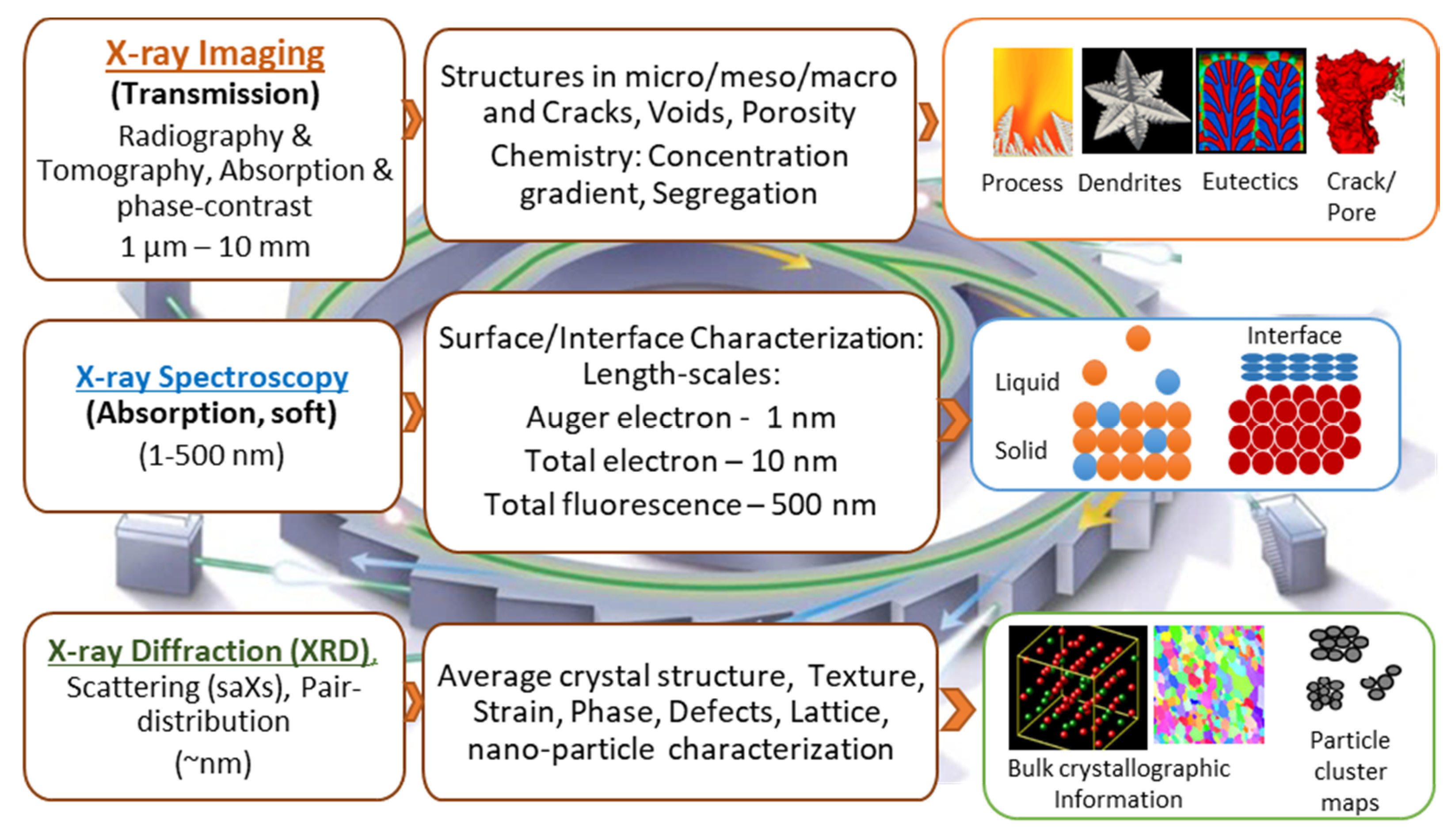


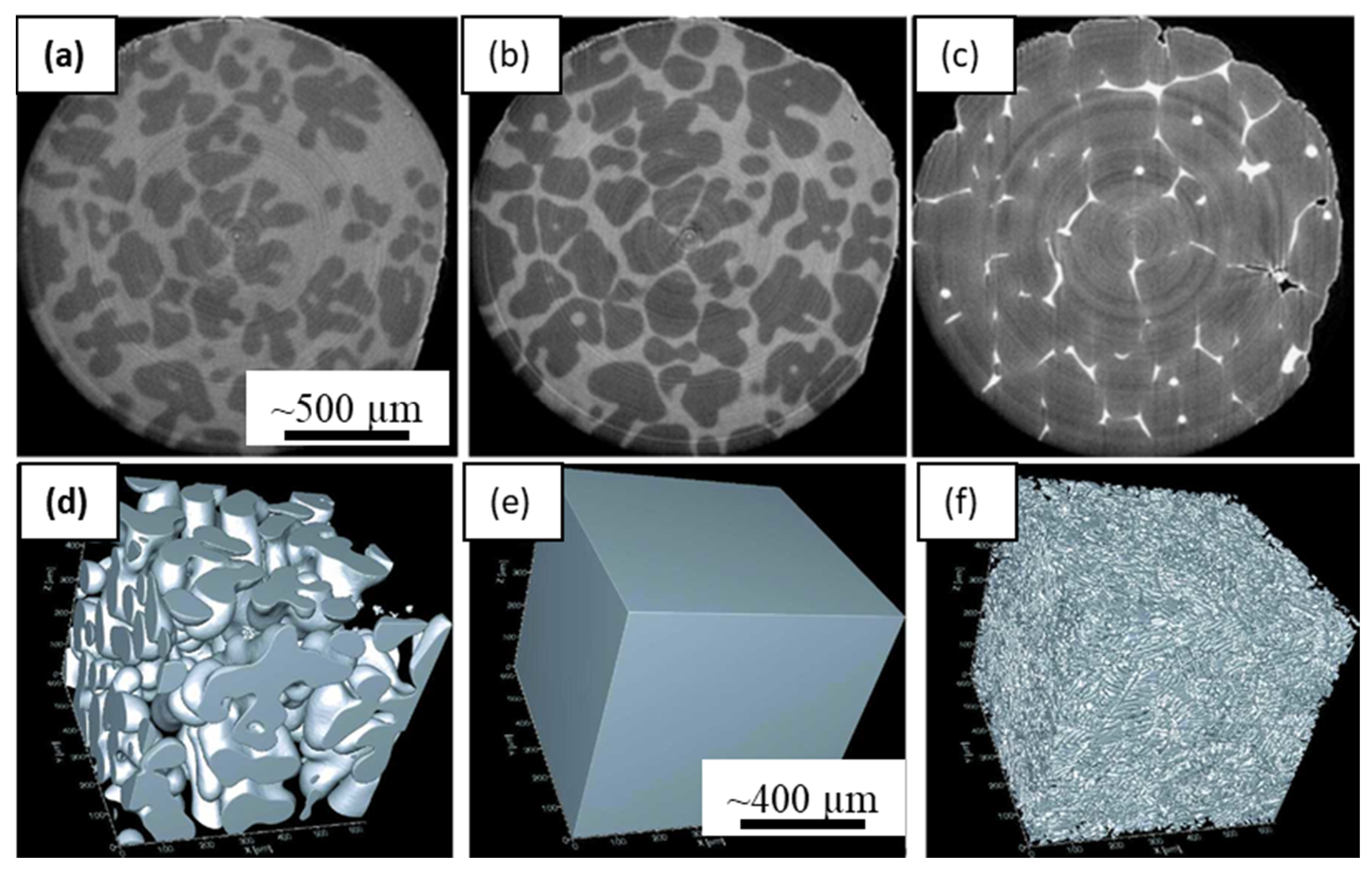
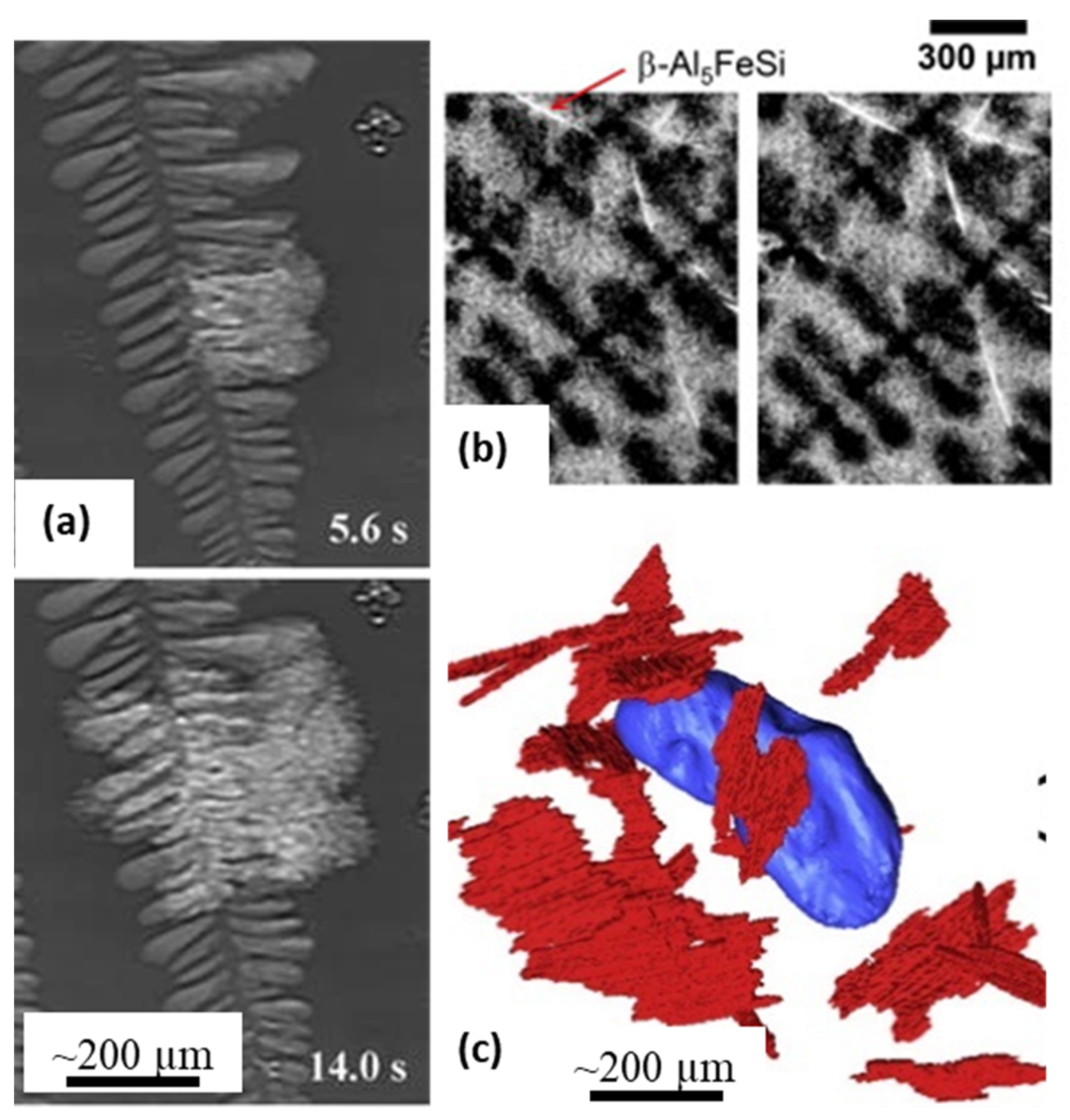
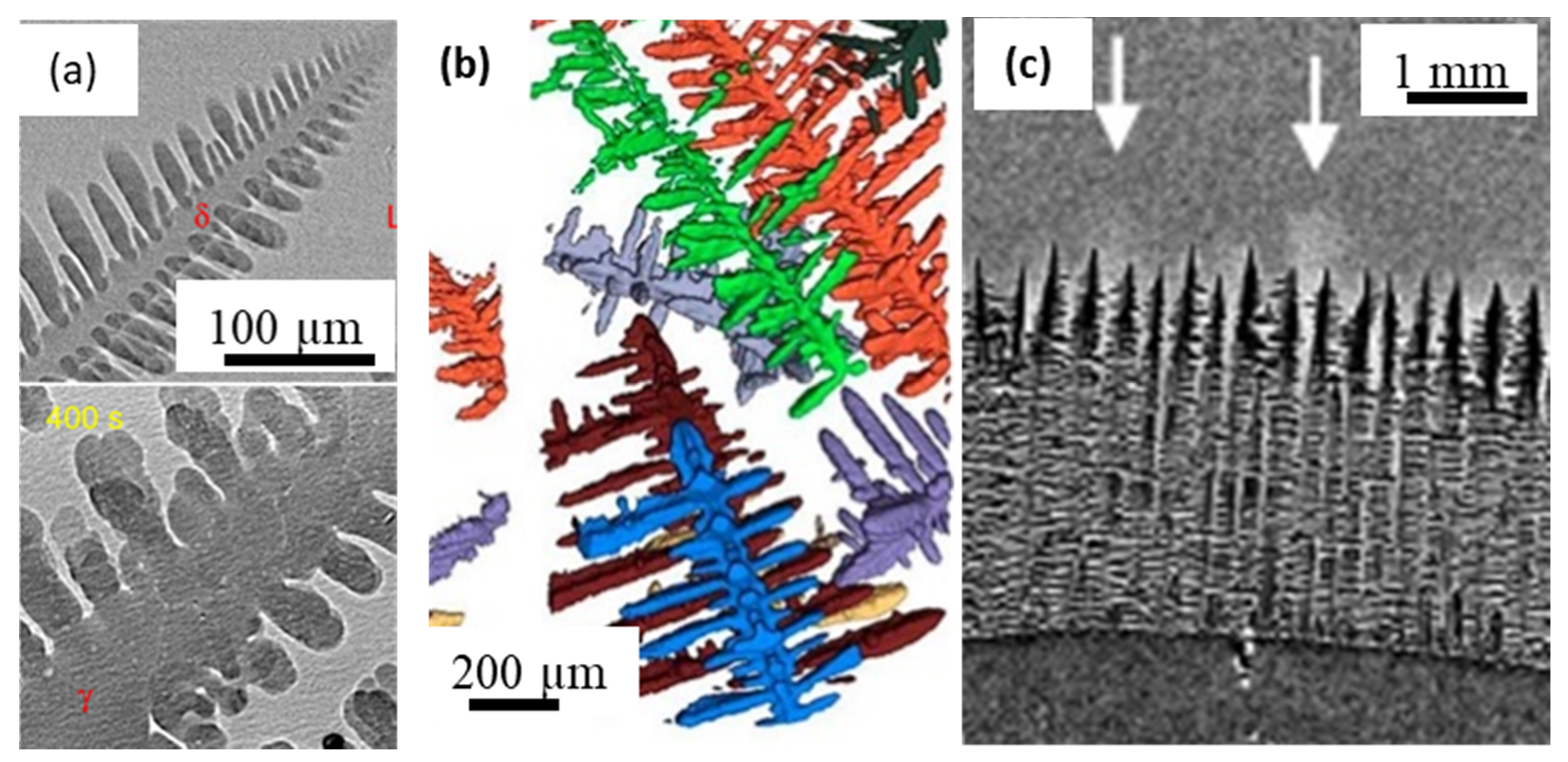
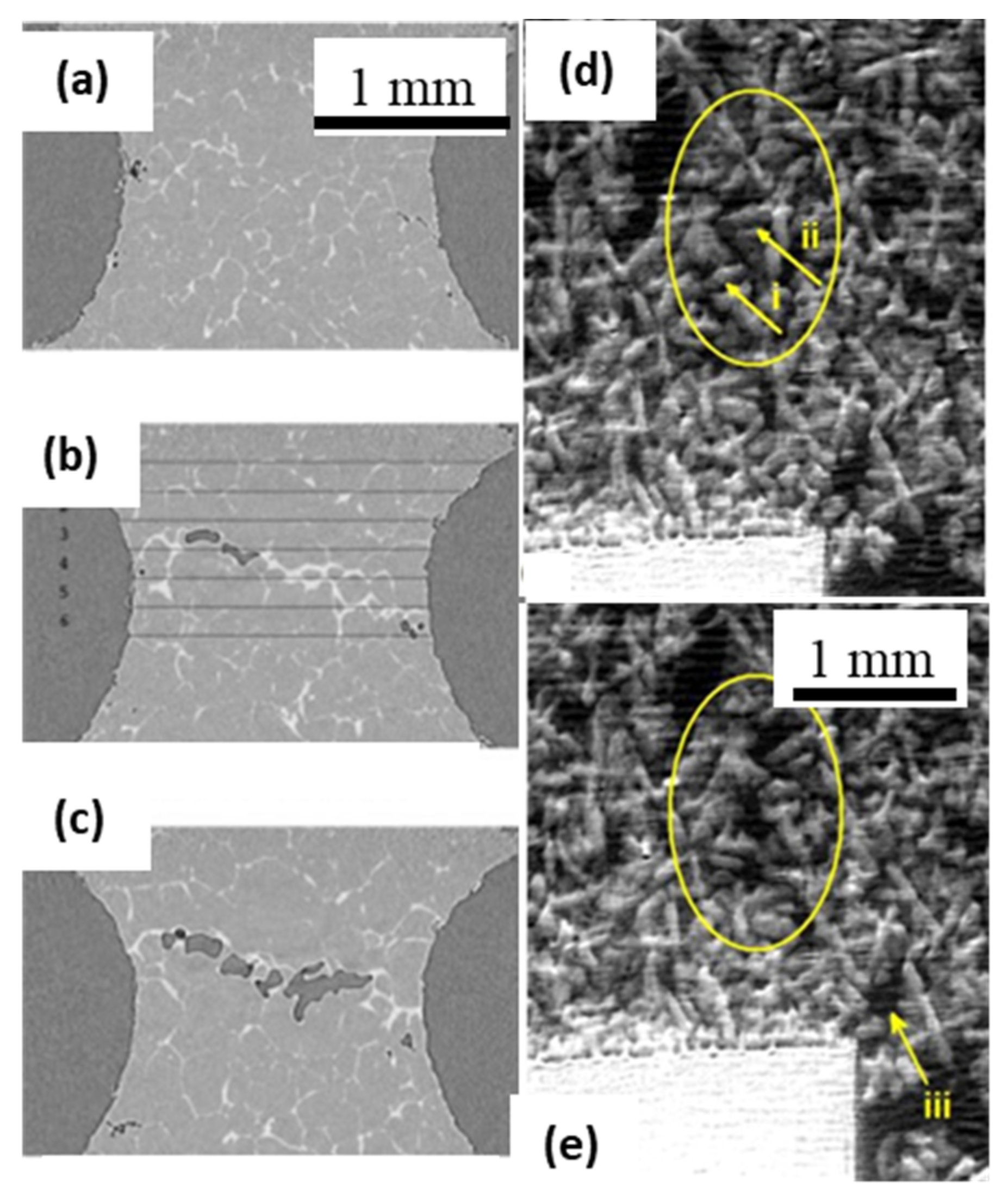



Publisher’s Note: MDPI stays neutral with regard to jurisdictional claims in published maps and institutional affiliations. |
© 2021 by the authors. Licensee MDPI, Basel, Switzerland. This article is an open access article distributed under the terms and conditions of the Creative Commons Attribution (CC BY) license (https://creativecommons.org/licenses/by/4.0/).
Share and Cite
Karagadde, S.; Leung, C.L.A.; Lee, P.D. Progress on In Situ and Operando X-ray Imaging of Solidification Processes. Materials 2021, 14, 2374. https://doi.org/10.3390/ma14092374
Karagadde S, Leung CLA, Lee PD. Progress on In Situ and Operando X-ray Imaging of Solidification Processes. Materials. 2021; 14(9):2374. https://doi.org/10.3390/ma14092374
Chicago/Turabian StyleKaragadde, Shyamprasad, Chu Lun Alex Leung, and Peter D. Lee. 2021. "Progress on In Situ and Operando X-ray Imaging of Solidification Processes" Materials 14, no. 9: 2374. https://doi.org/10.3390/ma14092374
APA StyleKaragadde, S., Leung, C. L. A., & Lee, P. D. (2021). Progress on In Situ and Operando X-ray Imaging of Solidification Processes. Materials, 14(9), 2374. https://doi.org/10.3390/ma14092374





